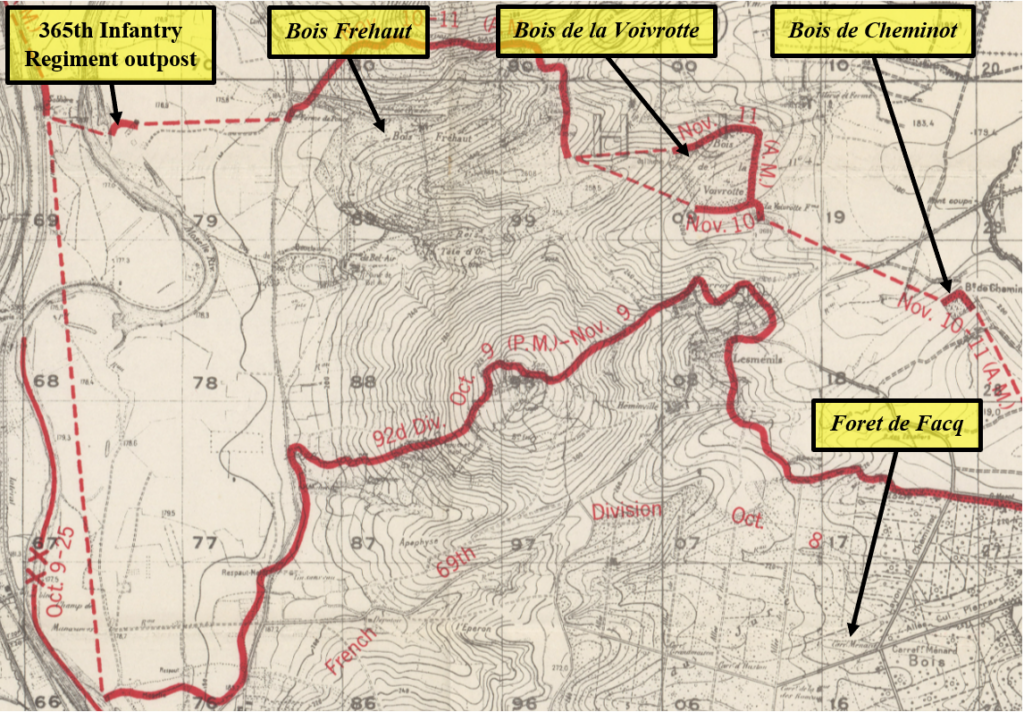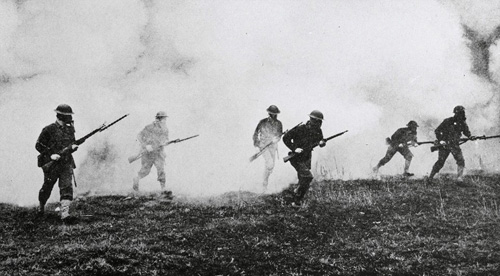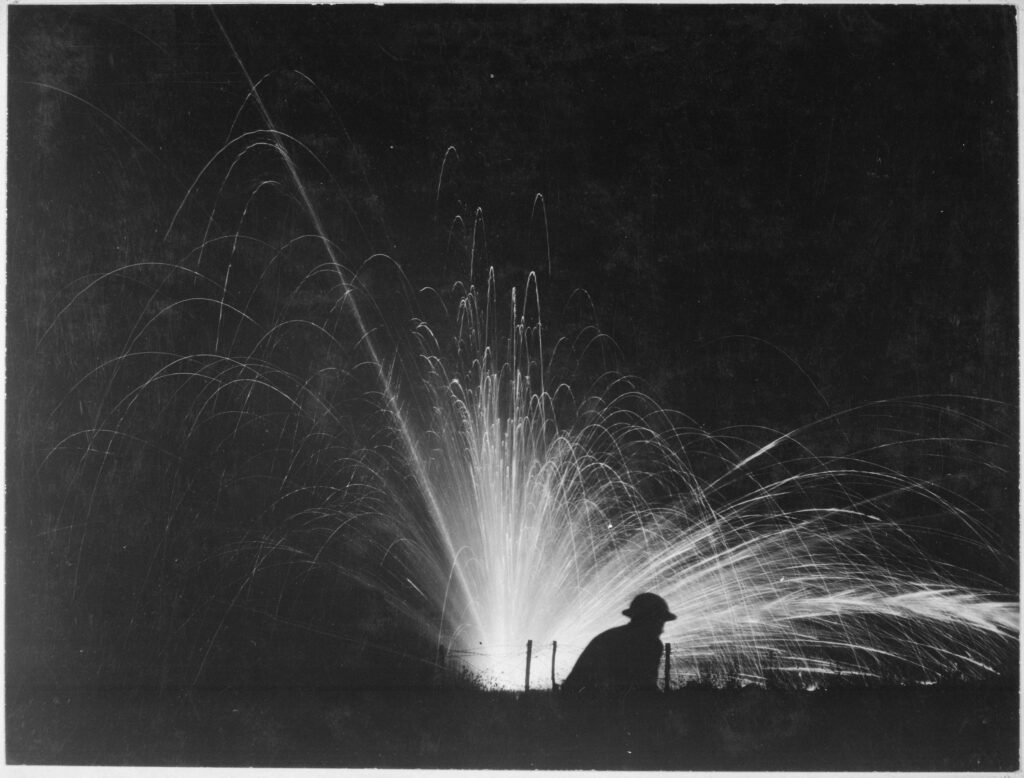Russell Pollard
Russell Pollard’s Personal Narrative was derived from information found in public records, military personnel files, and local/state historical association materials. Please note that the Robb Centre never fully closes the book on our servicemembers; as new information becomes available, narratives will be updated to appropriately represent the life story of each veteran.
Please contact the Robb Centre for further clarification or questions regarding content or materials.
*Note: Pollard has two birth dates indicated on paperwork (22 October 1895 and 22 March 1896) and an alternate unit listed (305th Infantry Regiment) upon Discharge.
Military Honor(s):
Distinguished Service Cross
Citation: The President of the United States of America, authorized by Act of Congress, July 9, 1918, takes pleasure in presenting the Distinguished Service Cross to Corporal Russell Pollard (ASN: 1967745), United States Army, for extraordinary heroism in action while serving with Company H, 365th Infantry Regiment, 92d Division, A.E.F., near Bois-Frehaut, France, 10 November 1918. During the assault on Bois Frehaut, Corporal Pollard, a rifle grenadier, conducted his squad skillfully in firing on hostile machine-guns until his rifle was broken. He then used his wire-cutter with, speed and skill under heavy shell and machine-gun fire, and although wounded in his right arm he continued to cut the wire with his left hand, and assisted his men in getting through it until ordered to the dressing station a second time by his company commander.
Life & Service
- Birth: 22 October 1895, Fort Worth, TX, United States
- Place of Residence:
- Race/Ethnicity: African American
- Death: January 1970 Yakima, WA, United States
- Branch: Army
- Military Rank: Corporal
- Company: [H]
- Infantry Regiment: 365th
- Division: 92nd
Russell Pollard was born to William Pollard (1845-?) and Sarah Caroline McConnell (1865-?) on 22 October 1895 OR 22 March 1896 OR 22 October 1885 (the least likely) in Fort Worth, Texas, the fifth of ten children; George (1887-1970), John (1890-?), Willie (1894-1949), Noland (1894-1978), Thomas (1897-1980), Jennie (1900-1994), McConnell (1901-?), S.B. (1904-?), and Betheny (1906-1985). Pollard was raised in Parker County, Texas where his father rented and farmed land in Justice Precinct 7. By the late 1910s, Pollard was living in Gracemont Township, Caddo County, Oklahoma, where he worked as a farmer.
Pollard enlisted in the U.S. Army on 26 October 1917 in Caddo County, Oklahoma. Private First Class Pollard and Co. H, 365th Infantry Regiment, 92nd Division left Hoboken, New Jersey aboard the U.S. Army Transport Ship Agamemnon on 10 June 1918. Then-Corporal Pollard received the Distinguished Service Cross for his actions near Bois-Frehaut, France on 10 November 1918,
“The President of the United States of America, authorized by Act of Congress, July 9, 1918, takes pleasure in presenting the Distinguished Service Cross to Corporal Russell Pollard (ASN: 1967745), United States Army, for extraordinary heroism in action while serving with Company H, 365th Infantry Regiment, 92d Division, A.E.F., near Bois-Frehaut, France, 10 November 1918. During the assault on Bois Frehaut, Corporal Pollard, a rifle grenadier, conducted his squad skillfully in firing on hostile machine-guns until his rifle was broken. He then used his wire-cutter with, speed and skill under heavy shell and machine-gun fire, and although wounded in his right arm he continued to cut the wire with his left hand, and assisted his men in getting through it until ordered to the dressing station a second time by his company commander.”
Wounded to an unknown degree, Pollard (listed as Private) left Bordeaux, France with the Casuals Convalescent Det. #13 aboard the U.S. Army Transport Ship Henderson on 19 March 1919. Pollard was again ranked as a Corporal for his Honorable Discharge on 8 August 1919.
Corporal Russell Pollard Served in Company [H], 365th Infantry Regiment, 92nd Division. At the time of his act of valor, his unit was a part of VI Corps, American Second Army. This is his story.
Marbache Sector – 10 November
6-7 November, 1918
Far from the dire straits faced at the beginning of the year, by early November, 1918, the tide of the war had turned in the Allies favor. Beginning in August, continuous Allied attacks had overwhelmed the German forces. With the Germans losing ground virtually every day, the Allies reasoned that they were likely to withdraw to a new defensive line where they might be able to hold-out until the Spring of 1919. As such, on 6 November General John J. Pershing gave orders to General Robert L. Bullard, the commander of the US Second Army, to conduct an offensive operation that would capitalize on the success of Pershing’s own First Army in the Meuse-Argonne Offensive. Though orders to pursue the Germans in case of withdrawal had already been given on 1 November, the orders of 6 November, 1918, called for a more aggressive disposition. The first plan, which had called for a wide pivot on the Second Army’s right flank to turn & face the strategically important fortress-city of Metz, was abandoned in favor of a bold frontal attack. The US IV Corps, in the US Second Army’s center, was to advance the Second Army’s line toward Waville. Meanwhile, the US VI Corps, which at the time was comprised solely of the 92nd Infantry Division, and the French XVII Corps were to support IV Corps’ advance with raids and artillery attacks from the flanks. The men of the 92nd Division found these orders most agreeable, as they had already spent the last month conducting deep combat patrols and, after the arrival of the 167th Field Artillery Brigade on 18 October, artillery strikes.

3rd Battalion, 366th Infantry Regiment, 92nd Division at Gas Mask Drill – Ainville, Vosges, France – August 8, 1918.
In preparation for the coming attack, the American Second Army had assembled a small hoard of chemical weapons, including No. 5 (phosgene) and No. 20 (yperite/mustard gas) artillery shells, as well as No. 27 (white phosphorous) rifle grenades. It is unclear how many of these weapons, if any, were actually used by the Second Army during the Woevre Plain Operation. However, the Allies were not the only ones armed for chemical warfare. Though the entire month preceding the Woevre Plain Operation, the artillery of the German Fortress Group at Metz had conducted extensive gas attacks, the purpose of which was to render critical staging areas along the Second Army’s Front uninhabitable. Owing to these “contamination shoots” as well as more typical barrages, the 92nd Division suffered some 258 cases of poisoning with mustard gas and diphenylchlorarsine during the period from when they first arrived in the Marbache Sector, on 9 October, until the end of the same month. However, when compared to the casualties suffered in neighboring units, such as the US 7th Division with a staggering 665 cases, the number of gassings in the 92nd Division were relatively low in light of the extensive gas shoots on their positions in and around the Lesménils Salient, the Foret de Facq, and Pont-à-Mousson. The 92nd Division Gas Officer credited the division’s strong gas discipline for this fact.
8-9 November, 1918
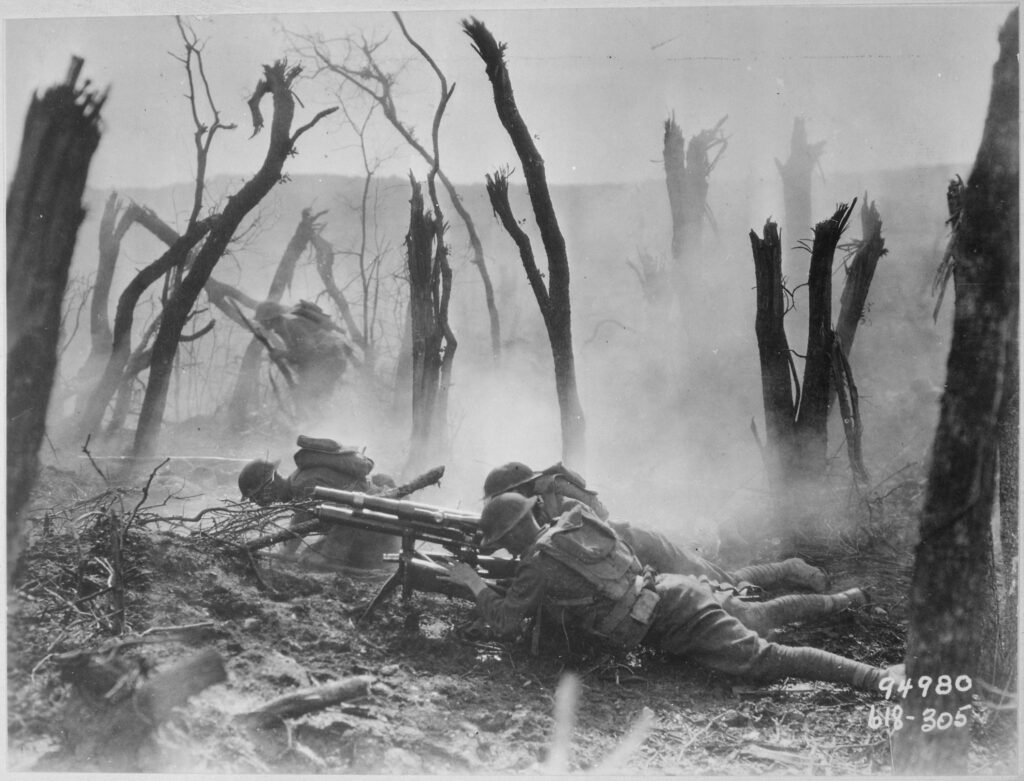
Gun crew from Regimental Headquarters Company, 23rd Infantry, firing 37mm gun during an advance against German entrenched positions.
On 8 November, VI Corps issued special orders to the 92nd Division to advance their line of observation ahead of Second Army’s attack on 10 November. The plan was simple: following a bombardment by the 167th Field Artillery Brigade, the 183rd Infantry Brigade was to advance the 92nd Division’s frontline to the Bois Frehaut, Bois de Voivrotte, and Bois de Cheminot at 0500 Hours (5:00 AM) on 10 November. A pair of assault groups from the 365th and 366th Infantry Regiments were assembled in the Foret de Facq on 8 November. 37mm Assault Guns, to be operated by members of the 167th Field Artillery Brigade, and a pair of companies from the 350th Machine-Gun Battalion were partnered with these units to provide heavy-weapons support during the attack. However, in light of the rapidly evolving situation on the Western Front, many of the details of this plan had to be changed at the last second.
On 9 November, the Second Army’s lines were a flurry of movement. Amid preparations to begin the offensive, orders came down from the Commander of the Allied Forces and Marshal of France, Ferdinand Foch, for all Allied armies to begin vigorous offensive operations against the Germans, who were now engaged in a general retreat along nearly the entire length of the Western Front. In accordance with Marshal Foch’s orders, at 2055 Hours (8:55 PM) General Pershing ordered the Second Army to begin its advance as soon as possible. However, when these orders were relayed to the corps commanders of the Second Army by General Bullard, they were dismayed; many of their forces were still preparing to advance, and would struggle to maintain organization if the attack was pushed up. Regardless, General Bullard was adamant: The Second Army must advance on 10 November in accordance with their new orders.
On the same day, General Charles C. Ballou, who had commanded the 92nd Division since its formation, was appointed the commanding officer of VI Corps. Consequently, Major General Charles H. Martin was appointed to lead the 92nd Division in his place, although since the 92nd Division was still the sole Division of VI Corps General Ballou was, effectively, still in charge. That afternoon, the assault battalions of the 365th and 366th Infantry Regiments, 183rd Infantry Brigade, moved to their jump-off points in Pont-a-Mousson and on the northern edge of the Foret-de-Facq, respectively. In the evening, the gas officers of the 92nd Division conducted mask inspections, and since the Germans were expected to use generous amounts of mustard gas to repel the American attack, protective sag-paste was issued.
That night, as the men rested for the coming battle, the officers of the 92nd Division met to finalize their plans. They decided that, over the course of the coming days, the 183rd Infantry Brigade was to push their frontline North to Corny-Sur-Moselle between the Moselle and Seille Rivers. The 2nd Battalion, 365th Infantry Regiment, was to move along the East bank of the Moselle River and capture the Bois Frehaut by the end of 10 November. Meanwhile, the 2nd Battalion of the 366th Infantry Regiment was to advance two platoons to the Bois de Voirvrotte on their right. One platoon was also sent to secure the tiny Bois de Cheminot to the East. Then, once these woods were secured, the remaining battalions of the 183rd Infantry Brigade would use them as a staging area for the next phase of the attack. On the left of the Moselle River, the 367th Infantry Regiment, 184th Infantry Brigade, was to work closely with the US 7th Division and cover the right flank of their attack on the Preny Heights. From its elevated position on the west bank of the Moselle, the 367th Infantry Regiment was also tasked with providing fire-support for the elements of the 183rd Infantry Brigade advancing on the other side of the river. The 368th Infantry Regiment was appointed the Divisional reserve and moved to a supporting position. These orders were sent out at 0045 Hours (12:45 AM) the following day, and the start of the operation was delayed from 0500 Hours (5:00 AM) to 0700 Hours (7:00 AM).
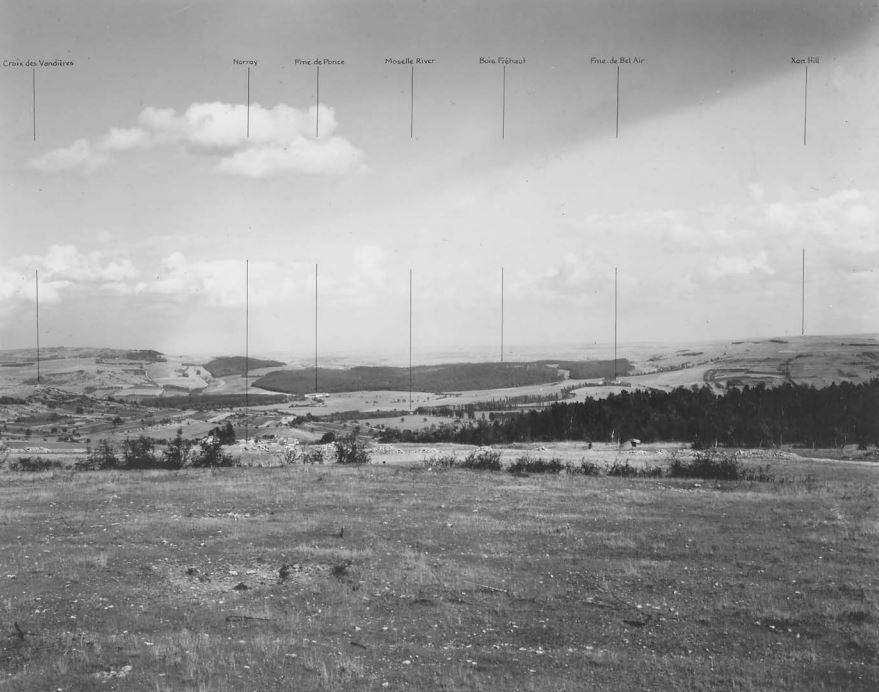
The view of the 183rd Infantry Brigade’s Area of Operations from the 367th Infantry Regiment’s position on the West Bank of the Moselle River.
10 November, 1918
At 0700 Hours (7:00 AM), the 365th Infantry Regiment made the first move. Advancing from Pont-a-Mousson, the men of the 2nd Battalion, 365th Infantry Regiment, moved quickly up the Moselle Valley towards the Bois Frehaut. Due to the speed of their attack, the 167th Field Artillery Brigade was unable to execute the heavy bombardment that they had originally planned to, and instead focused their fire on enemy machine-gun nests with high-explosive and incendiary shells. However, despite these targeted strikes, German machine-gun and artillery fire scoured the Moselle Valley during the 365th Infantry Regiment’s advance. Regardless, within the hour, the 365th Infantry Regiment had gained a foothold in the Bois Frehaut and, under covering fire from the 367th Regiment’s machine guns on the opposite bank, established an outpost on the Moselle River. The 366th Infantry Regiment, to their right, made a similarly rapid advance on the Bois de Voivrotte, reaching its southern edge by 0800 Hours (8:00 AM).
Contrary to what had been expected, the Germans in the American Second Army’s sectors were retreating in good order and had maintained strong outposts along their front to delay any pursuing force. Thus, as soon as the assault elements of the 183rd Infantry Brigade had reached the southern boundaries of the Bois Frehaut and Bois de Voivrotte, an intense machine-gun battle broke out in the woods between the American and the German forces. In this fight, the quick neutralization of the enemy guns was essential and, as a rifle grenadier, Corporal Russell Pollard was well-equipped for this task. Leading a small squad through the woods, he demonstrated great skill in eliminating the enemy’s guns until, due either to enemy fire or a catastrophic weapon malfunction, Corporal Pollard’s rifle was destroyed and he was badly wounded in the right arm. However, though he was told to retreat and seek medical assistance by his company commander, Corporal Pollard instead chose to stay with his men. Even as German artillery fire began to pour into the Bois Frehaut, he used his one good arm to clear barbed wire for his men until, surprised to find Pollard still at the front, his commanding officer ordered him to fall back a second time.
The following day, 11 November, 1918, at 1100 Hours (11:00 AM), an Armistice was signed between Germany and the Allied Powers. The end of the war to end all wars had come.
For his outstanding courage, skill at arms, and devotion to duty, Corporal Russell Pollard was awarded the Distinguished Service Cross in 1919 under General Orders No. 44.
Upon return to the United States, Pollard married Clara Temple (1897-1926) on 1 January 1920 in Caddo County, Oklahoma. After her death in 1926, Pollard married Ethel (maiden unknown) (1911-?). The couple lived in East McKinley, Oklahoma into the 1930s, where Pollard worked as a butcher at a slaughter-pen. By the 1940s, they moved to Pima, Arizona, where Pollard worked as a gardener. Finally, in the 1950s, the couple lived in Yakima, Washington, where Pollard stated he was unable to work due to a disability incurred within Army service. Details related to the following two decades are unknown; Pollard died on 28 January 1970, and is buried at Tahoma Cemetery, Yakima, Washington.
